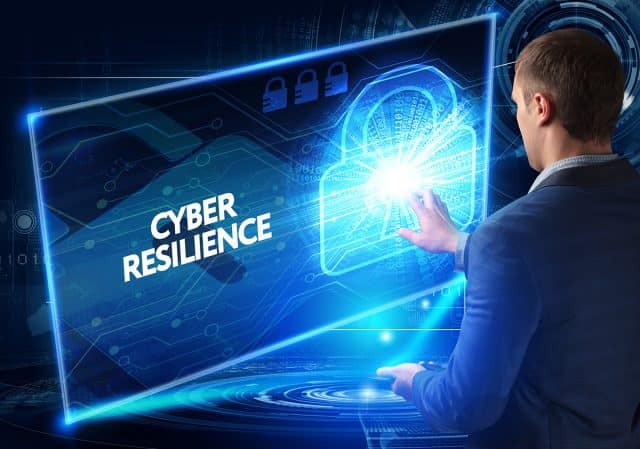
Because of AI, data has become the most valuable competitive asset for organizations regardless of industry. However, cyber-attacks are continuing to escalate, so the need for robust security measures is more important than ever. It is no longer enough to focus solely on prevention, so organizations must shift their mindset and resources toward rapid recovery and resilience.
For years, IT leaders have funneled time and investments into hardening their networks, building firewalls, and implementing the latest access controls to prevent breaches from malicious threat actors. Yet, despite these efforts, the unfortunate reality remains: cyberattacks, particularly ransomware attacks, are no longer a question of “if,” but “when.”
Organizations must have a cyber resilience strategy to prepare their IT infrastructure and internal processes, not only to prevent or withstand an attack, but also to recover fully and quickly in its aftermath without spending more than they can afford. This will ensure minimal disruption and a quick resumption of internal operations when the inevitable attack occurs.
Resilience as a Necessity
While this approach may seem straightforward (or even like common sense), IT leaders face significant challenges in embedding resilience within their systems and their organizations. Among the most pressing vulnerabilities enterprises currently face are outdated backup technologies (34 percent), a lack of backup data encryption (31 percent), and failed data backups (28 percent). Each of these issues represents a weak point that can lead to devastating data loss and prolonged downtime following an attack.
To truly have cyber resilience, the definition encompasses an organization’s ability to prepare for, withstand, and swiftly recover from attacks. The goal is to ensure that operations remain functional and maintain business operations even in the face of disruption, with minimal financial and reputational impact. In this framework, data protection and backup technology have evolved from an afterthought into a cornerstone of resilience strategies, serving both as a safeguard against failures and a tool for compliance with stringent regulatory requirements.
Backups and Resilience Strategies
To transition from the legacy static preventative mindset to one that prioritizes a dynamic recovery response, organizations need to evaluate and optimize their backup and resilience strategies. A robust and responsive cyber resilience plan requires multiple layers of protection and redundancy through various levels of infrastructure. That way, critical data remains secure and recoverable even if attackers manage to breach the primary network.
One of the most effective tools to help accomplish this goal is the adoption of all-flash in backup solutions. If a data solution utilizes high-performance NVMe flash drives, it dramatically accelerates backup, replication, and quick recovery processes.
Because of this acceleration, IT teams can perform more frequent point-in-time copies to meet more stringent recovery point objectives, ensure that a clean backup copy exists just prior to infection, and minimize data loss during a cyber event. That way, when an attack does occur, organizations can restore data faster, ensuring business continuity with minimal downtime.
Another important tool in the cyber resilience arsenal is immutable backups. These read-only and network-inaccessible copies of data prevent ransomware or malicious actors from altering or deleting stored backup data altogether, which provides a guaranteed unaltered version that can be quickly restored following an attack. Because ransomware attacks often involve encrypting or corrupting primary storage, having immutable backups helps organizations recover with minimal disruption, thus reducing both financial and operational impacts.
Encryption is also an important part of securing backup data. Combined with a variety of zero trust approaches, it helps protect sensitive information from unauthorized access, so even if attackers manage to infiltrate a network, they can’t easily exploit stored data.
When combined with all-flash backup and deduplication, encryption further enhances an organization’s ability to recover from attacks — all while maintaining compliance with industry regulations.
Storage efficiency and deduplication are a few more important factors in a resilient backup strategy. By eliminating redundant data, deduplication reduces the overall storage footprint, which enables IT managers to maintain multiple recovery points without requiring excessive infrastructure expansion. With this capability, organizations have multiple uncorrupted data versions readily available for restoration, which bolsters their resilience even further against cyber threats.
Finally, offsite and offline copies are another fundamental component of an organization’s backup strategy — one that has existed for as long as data storage itself. By maintaining off-site backups, for example, in the cloud or at a disaster recovery site, enterprises can ensure that a secure, recoverable copy of data remains available even if local systems are compromised. Offsite and offline backup copies also offer geographic redundancy, protecting data from threats like natural disasters or system failures.
Building a Future-Proof Cyber Resilience Strategy
Achieving true cyber resilience will require a comprehensive approach that prioritizes rapid recovery, secure storage, and reliable backup solutions and strategies.
By investing in all-flash backup technologies, leveraging deduplication and encryption, enhancing security with immutable copies, and implementing classic offsite and offline copies, organizations will be better prepared to recover from cyberattacks with minimal disruption or downtime.
Because of this, resilience should be a top priority for IT leaders who are focused on business continuity and reducing the overall impact cyber events — but technology alone is not enough. The right data protection technology has to be match by well-defined policies and procedures. Regular validation of backup integrity, for instance, is critical — regardless of the data’s age or recent use, every backup should be tested to confirm its reliability.
By adopting this proactive approach to cyber resilience, organizations can shift from a reactive or preventative stance to one that embraces the inevitability of cyber threats. With the right combination of technology, strategies, and an empowered IT team, organizations will be well-prepared to recover quickly in the event of a cyberattack and emerge stronger in the aftermath.
Image Credit: putilich/depositphotos.com
Tim Sherbak is Enterprise Products Marketing, Quantum.


